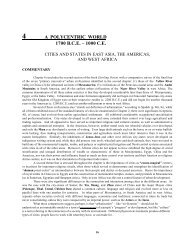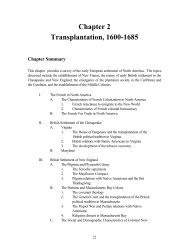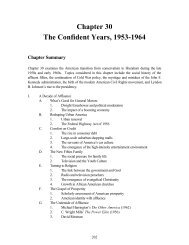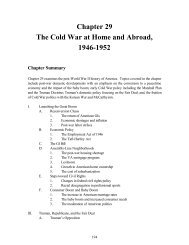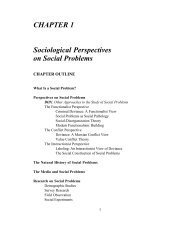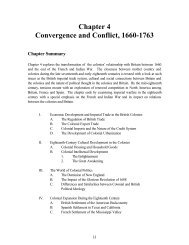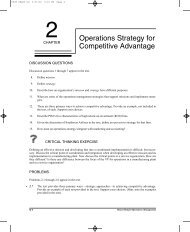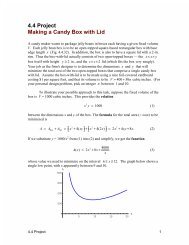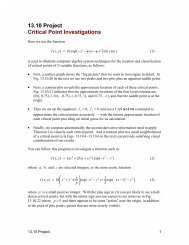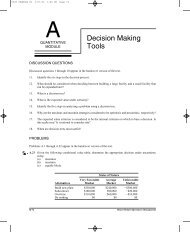Merchandising Operations and the Accounting Cycle - Pearson
Merchandising Operations and the Accounting Cycle - Pearson
Merchandising Operations and the Accounting Cycle - Pearson
Create successful ePaper yourself
Turn your PDF publications into a flip-book with our unique Google optimized e-Paper software.
Requirement 2<br />
Inventory Cost of Goods Sold<br />
June 3 1,610 June 9 644 June 12 550 June 22 480<br />
15 5,000 12 550 18 1,180<br />
16<br />
22<br />
260<br />
480<br />
18<br />
24<br />
1,180<br />
150<br />
Bal. 1,250<br />
30 865<br />
Bal. 5,691<br />
Requirement 3<br />
The decision to borrow funds was wise, because <strong>the</strong> discount ($150) exceeded <strong>the</strong><br />
interest paid on <strong>the</strong> amount borrowed ($95). Thus <strong>the</strong> entity was $55 better off as a<br />
result of its decision.<br />
Cyber<br />
Coach<br />
Visit <strong>the</strong> Student Resource area of <strong>the</strong> <strong>Accounting</strong> Companion Website<br />
for extra practice with <strong>the</strong> new material in Chapter 5.<br />
www.pearsoned.ca/horngren<br />
Adjusting <strong>and</strong> Closing <strong>the</strong> Accounts of a<br />
Merch<strong>and</strong>iser<br />
A merch<strong>and</strong>ising business adjusts <strong>and</strong> closes <strong>the</strong> accounts <strong>the</strong> same way a service<br />
entity does. If a work sheet is used, <strong>the</strong> trial balance is entered <strong>and</strong> <strong>the</strong> work sheet<br />
is completed to determine net income or net loss. The work sheet provides <strong>the</strong> data<br />
for journalizing <strong>the</strong> adjusting <strong>and</strong> closing entries <strong>and</strong> for preparing <strong>the</strong> financial<br />
statements.<br />
Adjusting Inventory Based on a Physical Count<br />
In <strong>the</strong>ory, <strong>the</strong> Inventory account remains up to date at all times. However, <strong>the</strong> actual<br />
amount of inventory on h<strong>and</strong> may differ from what <strong>the</strong> books show. Losses due to<br />
<strong>the</strong>ft <strong>and</strong> damage can be significant. Also, accounting errors can cause Inventory’s<br />
balance to need adjustment ei<strong>the</strong>r upwards or, more often, downwards. For this<br />
reason virtually all businesses, such as <strong>the</strong> grocery chain Loblaws, take a physical<br />
count of inventory at least once each year. The most common time for a business to<br />
count its inventory is at <strong>the</strong> end of <strong>the</strong> fiscal year, before <strong>the</strong> financial statements are<br />
prepared. The business <strong>the</strong>n adjusts <strong>the</strong> Inventory account to <strong>the</strong> correct amount on<br />
<strong>the</strong> basis of <strong>the</strong> physical count.<br />
Exhibit 5-5, Austin Sound Centre Inc.’s trial balance at December 31, 2004, lists a<br />
$40,500 balance for inventory. With no shrinkage—due to <strong>the</strong>ft or error—<strong>the</strong> business<br />
should have on h<strong>and</strong> inventory costing $40,500. But on December 31, when Frank<br />
Ernest, <strong>the</strong> manager of Austin Sound, counts <strong>the</strong> merch<strong>and</strong>ise in <strong>the</strong> store, <strong>the</strong> total<br />
cost of <strong>the</strong> goods on h<strong>and</strong> comes to only $40,200. Austin Sound would record <strong>the</strong><br />
inventory shrinkage of $300 (which is $40,500 – $40,200) with this adjusting entry:<br />
OBJECTIVE 3<br />
Adjust <strong>and</strong> close <strong>the</strong> accounts<br />
of a merch<strong>and</strong>ising business<br />
under <strong>the</strong> perpetual inventory<br />
system<br />
KEY POINT<br />
If inventory exceeds physical<br />
inventory, in <strong>the</strong> accounting<br />
records, inventory would be<br />
adjusted downwards. As a result<br />
of this inventory adjustment, cost<br />
of goods sold is higher <strong>and</strong> gross<br />
margin is lower. The cost<br />
associated with buying <strong>the</strong>se<br />
missing units is not accompanied<br />
by <strong>the</strong> revenue from a sale.<br />
Therefore gross margin shrinks by<br />
this amount (cost).<br />
Chapter Five <strong>Merch<strong>and</strong>ising</strong> <strong>Operations</strong> <strong>and</strong> <strong>the</strong> <strong>Accounting</strong> <strong>Cycle</strong> 237



